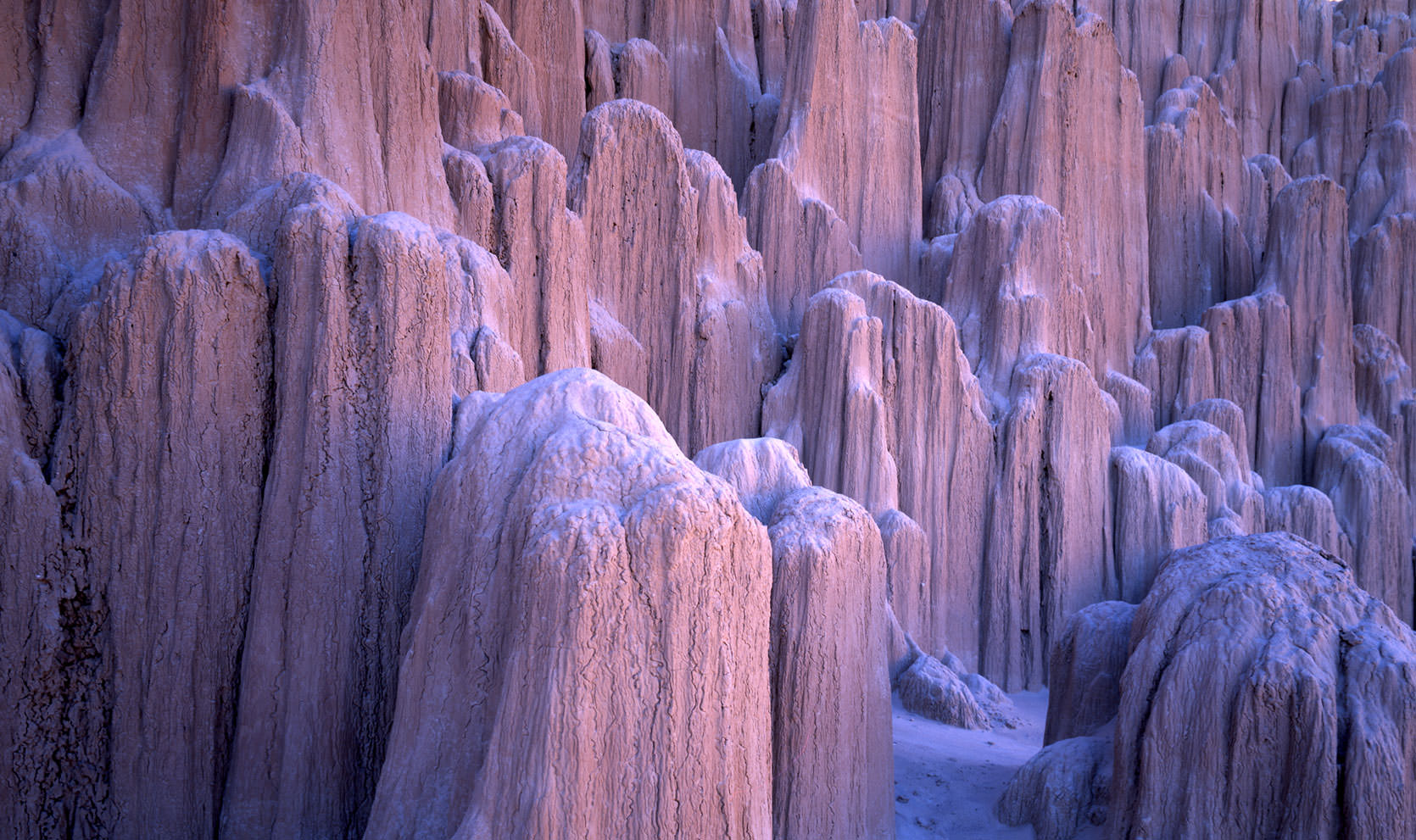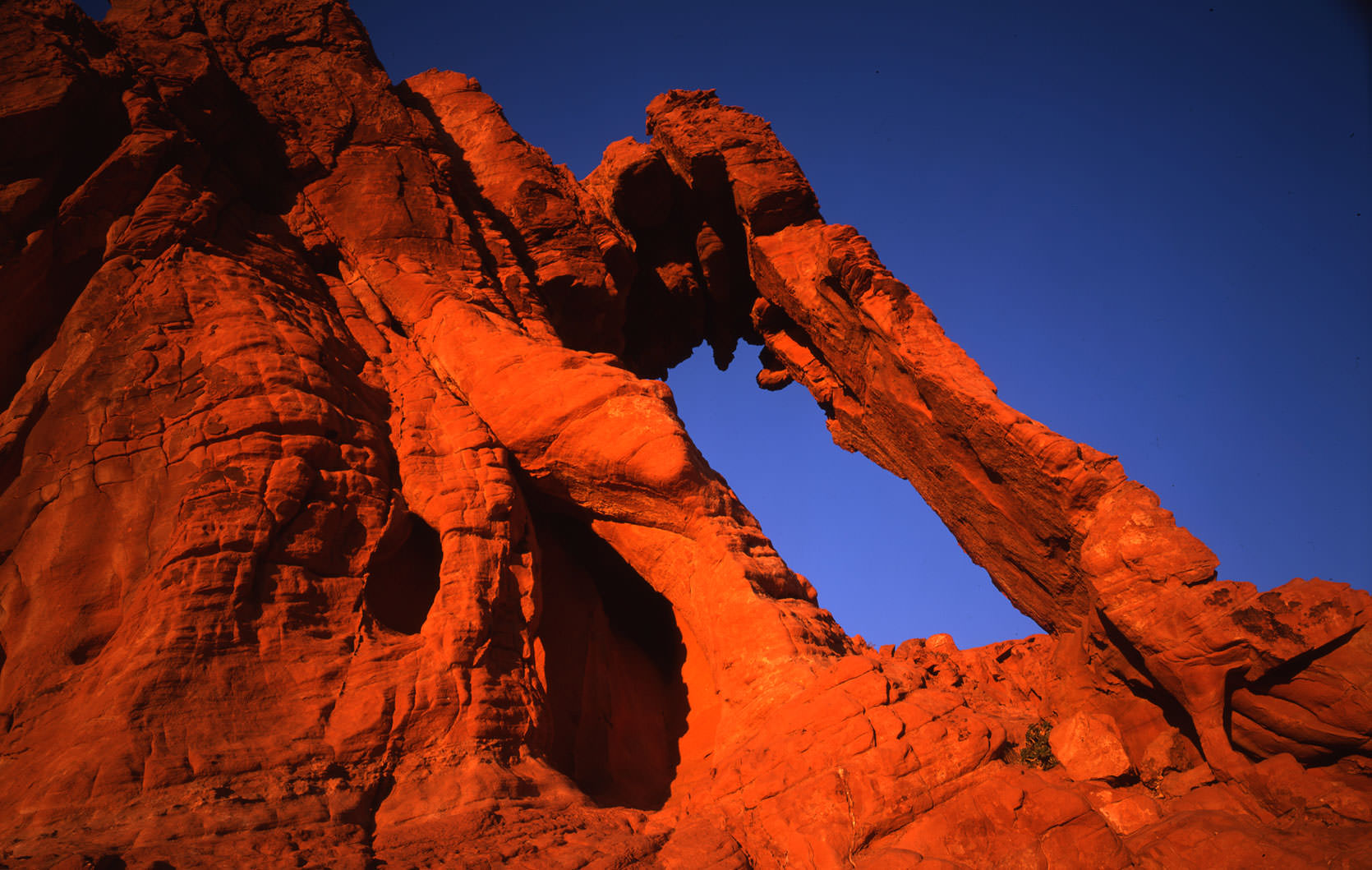Great Basin

Rocks and Mythology in
Rachel, Nevada
Notes from Nevada desert outpost, where UFOlogistcs converge to talk about their theories on Area 51.
Published in 2001, updated March 31, 2025.
North into the Nevada desert from Las Vegas for a hundred fifty miles or so. No trees, no towns, no humans or a goddamned bit of greenery to speak of. You call this straight road miserable, but you haven't yet been to Rachel, pop. 100, whose only claim to fame is that it is the closest town to Area 51, America's famously secret experimental military installation.
I pulled over a slim hill and saw Rachel sparkling by the light of the moon,
a dozen mobile homes and some trash sticking out of the dirt.
Yes, Area 51 is classified, but terms like "top secret" give it a false sense of mystery. It's a dusty sprawl of hangars at the bottom of a dry lakebed—a place so remote the Air Force chose it to test stealth aircraft and missile technology. Just yesterday, three F-117s flew over my truck. They're very cool, and of course, very much of this world.
I stopped in at the The Little A'Le'Inn. I wanted a beer, but I got the universe. The décor? Pro-extraterrestrial, pro-gun, anti-Hillary. The Little A'Le'Inn has become a mecca for believers, though you wouldn't know it by the slouched drinkers at the bar.
Bill was talking to Howard.
"How long you been truckin'?" he asked.
"Since nineteen forty-eight."
"Nineteen forty-eight? You are a good man, Howard. What, Freightliner?"
"Dodge."
"A Dodge man?"
"All my life. I move cars, boats, trailers, trucks."
"Always?"
"That's my specialty."
Bill patted Howard on the back—a little too hard, maybe. Howard was old.

B
ob, who was listening in, said that he liked trucks. Bob looked like he had been reverse engineered from a human: bald, aging, a skeletal face beneath a long, sun-bleached goatee. He seemed to have been drinking since morning. His drawls were long and nearly inaudible—he had reached that state of drunken equilibrium: no highs, no lows, just a fuzzy hum and squint-eyed smiles.
I took a seat at a corner table, a quiet spot to read. I didn't know that soon, the entire bar would be seated around me, sharing their stories. Maybe I appeared the most unusual—glasses, a buttoned shirt. Or maybe it was the book.
"I'm an aerial photographer," Bill said. "I come here every year. Beautiful country. Born and raised in New Jersey. But I really belong here. I'm a Western guy at heart." He added, in a Jersey accent, "My Stetson is from Montana."
"What are you shooting out here?" I asked.
"Well, you get these combat exercises this time of year. They're flying all over—Army, Navy, Air Force. Too bad none of that's going on now; they're all deployed."
"How do you do it?"

Abandoned mine outside of Rachel, Nevada
"T
here are these roads that head toward Groom Lake. There are still a couple spots left where you can get a decent view of Area 51. I mostly shoot F-14s, F-15s, that sort of thing. I use a Nikon. F1.4 and one-eight-thousandths of a second. All I need is a little moonlight and I can get a picture."
"What have you seen? What have you shot?"
"I started coming out in '92. You go out to the public stretch of Groom Lake Road during the combat exercises. The planes see your dust trail and you're like the automatic target. They descend on you—you've been 'a kill' a hundred times. That's when you shoot back. They're just playing because you're the only interesting thing out there."
"What's the best thing you've seen?"
"Well, it's what I saw, not what I shot. Back in '92, I was watching from Tikaboo Peak. I saw these black-winged craft flying at night. Didn't get the shot, but I told everyone back in Jersey. Nobody believed me. We all know now they were declassified F-117s. You've got to learn to only tell people what they want to believe."
That was my cue. I'd heard it before. The UFO crowd treats belief the way someone with an unusual religion might—shy in the face of mockery, but explosively chatty when met with even mild curiosity. I said I thought the government was coming up with a way to make everyone the middle child.
A few minutes later, Bill said, "It was a mile wide. I just saw it for a second. It hovered there for a moment, then disappeared over the mountains."

The Beehives, Valley of Fire State Park, Nevada
B
ob was listening. "I like science fiction movies," he said. "I really like Forbidden Planet."
Two middle-aged brothers from Las Vegas walked in and took seats at my table. Pat, who was serving coffee, asked if they wanted the usual.
"No," said the younger. "Got any blueberry pie?"
"Just one left for you."
"I'll take the cherry," said the older.
I asked what brought them to Rachel.
"Minding our own business."
"Hunting?"
"No hunting for us. We bought a place out here."
"Why?"
"To get away from Vegas," the older one said, already working on his slice of cherry pie from the Little A'Le'Inn.
"Speaking of hunting," he added, addressing the whole table, "why are there dead coyotes strung up everywhere?"
"I think it's to attract them," Bill said. "To snare 'em."
"No," Bob said slowly, "that's how you mark your territory. You string up them coyotes on your fence posts—it keeps them away. One gets too close, you kill 'im. You hang him on your fence. The coyote smells his own death. He knows not to come after your dogs or your chickens."

Cathedral Gorge, Nevada
W
hat I found most peculiar about the patrons of the Little A'Le'Inn was their common reverence for southern Nevada. "Most gorgeous country in America," Bill had said. Passing through, here for the aliens, or just here to live, the miserable desert emptiness seems to compel—if not unite—a strange crowd of loners.
Rachel has none of Nevada's usual attractions. Its appeal lies in roadside kitsch. The posted speed limit is Warp 7. Though Rachel is now a minor tourist destination, the strangely magnetic emptiness—the long, upward-curving flats and distant, pastel ranges—remains passed over by most visitors to the Southwest.
In 1996, Nevada's governor renamed State Route 375—an arc that sweeps around Area 51—the "Extraterrestrial Highway." He promoted it alongside the release of a summer blockbuster about flying saucers that destroy Earth and kill billions.
The folks in Rachel don't spend much time talking about UFOs—except when outsiders ask, or when brainstorming new tourist lures. Aside from its recent notoriety, not much has happened here.
Until July 12, 1986.
That day, a smooth, metallic flying object blared down from the sky. It wasn't an alien, but close enough: Leif, a Norwegian F-16 pilot, crashed just between the trailer park and the playground during a training mission with the U.S. Air Force.
When he recovered, Leif sent a letter to the community. Along with it, he mailed Norwegian Air Force patches as a token of thanks. He wrote:
"On both [of these patches] you can see the relationship to the Vikings. Norway is famous for the Vikings who ravaged for some centuries ago. And again, Merry Christmas and Happy New Year."
Leif was from Saltnes, a green, steep-valleyed town near Stavanger in southern Norway. In Old Norse, a saltnes refers to a rock outcropping used for drying salt.
Back when Norwegians dried salt on fjord rocks, they also believed in trolls—mythical little forest dwellers. These weren't benevolent creatures; trolls were tricksters, and they ate children.
The Norwegians weren't alone. The Irish had leprechauns. Scots had pixies and tommyknockers. In Slavic folklore, krasnoludki were so small they could hide beneath grass. They helped with chores—unless mocked, in which case they pissed in your milk or made trouble around the house.

Abandoned Mine near Rachel, Nevada
C
herokee mythology warned of three groups of mischief-makers the height of your knee. The most feared, the rock people, would steal your children if disturbed.
In the Philippines, dwende—forest-dwelling elves—live in earthen mounds. Get too close and they'll kill you.
In Hawaii, Menehune are small, elusive builders of caves and ditches who emerge only at night.
Everywhere, cultures have imagined little people in the woods. Humans share deep-seated fears and common mythologies. Like rabbits born afraid of fangs, we invent stories to explain the unknown. In a time when forests are mapped and magic no longer fits, we piece together our modern fears—of space, of surveillance, of vanished wilderness—into new myths. Little gray aliens reflect the anxieties of suburban, secular America.
Some polls suggest 65% of Americans believe the government is hiding evidence of extraterrestrial life. Many are familiar with the stories from Roswell, New Mexico: beings with gray skin and black eyes, long fingers at home with a keyboard; a spacecraft locked away in a hangar; a team of white-coated engineers taking it for midnight test drives at Area 51.
There's tension between UFOlogists and mainstream scientists. UFOlogy is often seen as crackpot science—a blend of faith and loose logic that muddies the serious, fascinating search for life beyond Earth. It's rigorous scrutiny versus face value. But is UFOlogy harmful?
Judging from the Little A'Le'Inn crowd, it doesn't seem so. I pointed out to them that Leif wasn't the first to come crashing into Rachel from the heavens.

Elephant Rock, Valley of Fire, Nevada
N
earby, there's a geological formation known for its curious fossil layer. Deepwater fish fossils are found alongside shallow-water mollusks—an unlikely combination. Scientists believe this odd mix was caused by a cosmic visitor some 375 million years ago. A meteor hit the sea that once covered the Great Basin, throwing sea life and sediment from the depths onto the shallows.
Today, southern Nevada forms the lower boundary of the Great Basin—a vast, self-contained hydrological region with no ocean outlet. Once a patchwork of lakes and inland seas, the Great Basin is now a desert of bold mountain ranges and endless scrub flats.
Southern Nevada's geology is starkly readable. The ranges run north-south like stalled semis on a freeway. Unlike the more eroded, tangled geographies of the East, Nevada's young mountains stand bare and clean. Most of North America's mountain ranges were formed by tectonic compression, but these are scars of extension—cracks from when the crust was stretched like plastic wrap.
In places like the Panaca Formation, 75 miles northeast of Rachel, the terrain reveals ancient sea-bottom turned cathedral. Mud hardened into pinnacles and ridges. Erosion carved the sediment into dark, winding slots with a bluish hue—cave-like, cool, almost moonlike. From Red Rock Canyon to the Valley of Fire, southern Nevada is rich with formations that fuel the imagination.
It's no wonder this is where the myths land.
